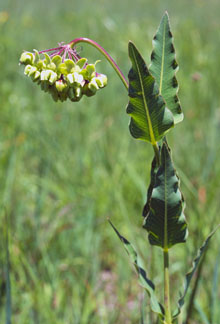MEAD'S MILKWEED
|
 |
| File Size: 106 KB |
|
|
|
Asclepias meadii Torr. ex A. Gray
|
| (photo by Craig Freeman) |
| Perennial |
| Height: 8 to 24 inches |
| Family: Apocynaceae - Dogbane Family |
| Flowering Period: May, June |
|
| Stems: | | Plants glabrous, glaucous; sap milky. Stems erect, simple. | | Leaves: | | Opposite; petiole absent; blade narrowly lanceolate to ovate, 2 to 3 3/5 inch long, 3/5 to 1 4/5 inch wide, apex acute. | | Inflorescences: | | Umbel-like cyme, terminal, 8--20-flowered. | | Flowers: | | 1/3 to 3/4 inch long, 1/4 to 3/5 inch wide; calyx lobes 5, lanceolate to triangular, 1/8 to 1/5 inch; corolla lobes 5, greenish cream sometimes tinged purple, lobes reflexed, lance-oblong to elliptic, 1/4 to 2/5 inch; hoods 5, greenish cream, petal-like, erect, 1/6 to 1/4 inch, margins with a pair of teeth distally, tip rounded; horns sickle-shaped, fused to bases of hoods, arching over anther head. | | Fruits: | | Pods, narrowly spindle-shaped, 3 to 4 inches long, 1/3 to 2/5 inch wide, smooth, glabrous; seeds ovate, ca. 1/3 inch; tufted with white silky hairs, 1 1/5 to 1 3/5 inch long. | | Habitat: | | Tallgrass prairies | | Distribution: | | East 1/4 of Kansas | | Origin: | | Native | | Comments: | | Mead's milkweed is a federally protected, threatened species. Most of the world's populations occur on tallgrass prairies in the Osage Cuestas of Kansas. Asclepias, for Aesculapius, the Greek god of medicine and meadii, for Samuel Barnum Mead, discoverer of plant. |
|
| Mead's milkweed leaves |  | | 169 KB | | Miami County, Kansas |
| | Mead's milkweed leaves |  | | 179 KB | | Miami County, Kansas |
| | Mead's milkweed |  | | 96 KB | | Miami County, Kansas |
| | Mead's milkweed |  | | 143 KB | | Miami County, Kansas |
| |
|
|
|
|
|
|






